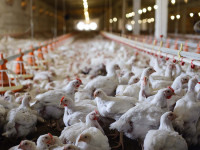Money
Nepalis became avid junk food eaters after 2015 earthquakes, report says
45 percent of Nepalis eat salty and fried snacks, and 11 percent consume zero vegetables.
Krishana Prasain
After the devastating earthquakes in 2015, Nepal saw a dramatic shift in dietary habits, stimulated by the inflow of cash for reconstruction. This massive cash inflow also led to an explosion in the availability of packaged snack foods.
Now, people are avid consumers of fast food and packaged foods, and the trading and manufacturing of such food businesses are growing exponentially.
This inadvertently increased the demand for unhealthy foods as people become accustomed to readily available options, according to the Global Food Policy Report 2024, published by the International Food Policy Research Institute recently.
These foods with low nutritional content are packaged and ready to eat at any given point.
“The emergency food aid provided after the earthquake included packaged foods like instant noodles,” the report said.
Poor diet quality is a significant reason for poor nutrition outcomes.
The report, authored by multiple experts, covers Africa, the Middle East and North Africa, Central Asia, South Asia, East and South East Asia, Latin America and the Caribbean.
According to the report, 45 percent of Nepal's population consumes salty and fried snacks. The country's vegetable intake has been poor, with 11 percent of the population consuming “zero” vegetables and fruits.
The report said progress is slowing on reducing undernutrition and micronutrient deficiencies in low- and middle-income countries while observing a rapid rise in overweight and obesity rates. This double burden of malnutrition—where undernutrition coexists with diet-related noncommunicable diseases—poses significant global health challenges.
The report also stresses that food systems significantly contribute to greenhouse gas emissions and environmental degradation, urging their transformation to reduce environmental impacts while ensuring food security. Malnutrition rates remain high, and non-communicable diseases are rising in South Asia.
“With the increased consumption of packaged food, particularly by the children, it has sharply increased childhood obesity. Overconsumption of zero nutrition and zero calorie packaged food has increased the malnutrition rate in children, especially school-age ones,” said Dr Sudhashree Adhikari, a nutritionist.
“Immature growth in children and disturbance in the menstruation cycle is being seen in women, largely due to the consumption of packaged and processed meat and dairy products. These products often contain growth hormones used in poultry, dairy, and cattle production.”
“Producers inject hormonal growth supplements into poultry to speed up production, and these hormones get stored in the animal’s organs,” she said. “When people consume these products, it can lead to hormonal imbalances.”
Adhikari said that hormonal imbalance in women and chronic hypertension and diabetes in men have sharply gone up mainly due to the high intake of carbohydrates that are found in packaged and processed food.
According to experts, the low and middle-income brackets have been cutting their healthy food intake from their plates with the rising prices of vegetables and dairy products.
The report said nearly 80 percent of Nepal's population cannot afford a healthy diet as healthier food options cost more in countries with poorer infrastructure and logistics.
It has been several months since the prices of most green vegetables crossed over Rs100 per kg. For instance, even a kg of bottle gourd, a common and seasonal vegetable, costs around Rs120 per kg in retail.
As Nepal does not produce enough fruits, most of the fruit requirements are fulfilled through imports. For example, a kg of Chinese Fuji apples costs around Rs400.
The report said that only 1.1 percent of Nepali adults (over 15 years old) consume 400 grams of fruits and vegetables daily, which is the WHO's recommendation.
Fruits and vegetables are rich sources of vitamins, minerals, fibre, and antioxidants that protect against numerous diseases.
According to Nepal Rastra Bank, vegetable inflation increased by 16.02 percent in mid-June compared to last year.
For example, lately, dairy companies have struggled to sell milk. They have converted the milk into powder and butter, but even these products remain unsold, leaving tonnes of the products piling up in the warehouses of the state-owned and private dairies.
Both state-owned and private dairy companies said the ongoing economic slowdown has dampened dairy demand, resulting in stopped cash flow and rising liabilities to farmers as products remained unsold for several months.
Nepal’s growth rate, which measures the country’s output and people's income, has remained dismal, averaging 3.4 percent in the last five years.
Import figures show the clear picture of how packaged foods have grown and displaced traditional food habit systems.
According to the Department of Customs, Nepal imported 2,420 tonnes of chocolates worth Rs1.66 billion in the last fiscal year ended July 15.
The country also imported 4,146 tonnes of sweet biscuits worth Rs997.62 million, 1,657 tonnes of Kurkure and Lays worth Rs911.78 million, 2,818 tonnes of dalmoth and namkeen worth Rs800.95 million, and 1,867 tonnes of packaged bakery items worth Rs612.58 million.
The country imported 1,609 tonnes of chewing gum worth Rs582.74 and 1,478 frozen French fries worth Rs226.26 million.
Hem Raj Regmi, the deputy chief statistician at the National Statistics Office, said that packaged and processed food consumption is increasing in the country mainly due to rapid urbanisation, a rise in single families, a growing number of working women, and changing food habits.
“The remittance is the key. It has fueled the consumption of such products,” said Regmi, who holds a doctoral (PhD) in food security.
He said that remittances affect food expenditure in two distinct ways.
“When you have money, you increase your calorie intake, but income from remittances may also compound trends toward purchasing less healthy foods associated with the nutrition transition.”
Experts said that unchecked sale of packaged and processed food items, especially in rural parts of the country, easy availability of counterfeit food and beverage products with no quality inspection, and the import of packaged food products high in palm oil and sugar are causing severe health issues in the majority of people.
The government's lax inspection has also led to an increase in traders selling expired food items by relabeling them.
In Nepal, 39 percent of the population consumes all five recommended food groups, including at least one starchy staple, one vegetable, one fruit, one pulse, one nut and seed, and one animal-source food, the study states.
The report said poor diets are caused by a mix of factors: insufficient crop diversity; low affordability due to low per capita income and higher prices of nutritious foods; inefficient, underdeveloped markets and value chains; easy access to highly processed foods; and aggressive promotion.
According to the poultry association, an egg now costs around Rs25 in retail, up from Rs17 a year earlier and has become out of reach for most low-income people.
The report said that in 2050, no countries in sub-Saharan Africa and few countries in Asia and the Pacific could supply the World Health Organization’s minimum recommended daily per capita intake of 400 grams of fruits and vegetables.
Adhikari said that vegetables and fruits fulfil the required micronutrients, like vitamins and minerals. Live enzymes, Vitamin B12, and calcium are also found in vegetables and fruits, and such products are less consumed.




 11.12°C Kathmandu
11.12°C Kathmandu













%20(1).jpg&w=300&height=200)
